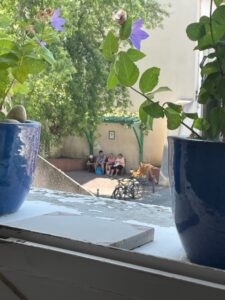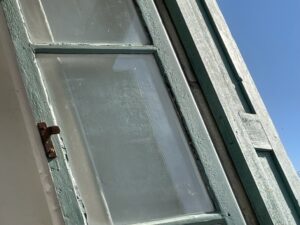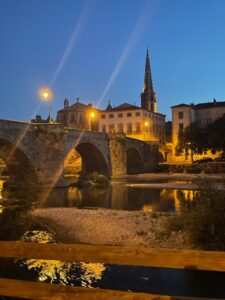Tour de France stage 16
Dayle in Limoux – Day #14
July 18, 2022‘As I relax into the flow of the miraculous, then miracles will find me.’
-Marianne Williamson
Miracles & magic, flowing in France. Thanks be to Gaia, la lune. A day of hydration and rest, an early evening walk with temps down to a cool 92. :) Never thought I’d appreciate 92 degree weather. Yesterday at the stage finish in Carcassonne, pushed the heat limits a bit. Needed to hydrate and stay out of the heat as much as I could today. Tomorrow a blur of color as the riders make it to Limoux for stage 16, final destination Foix.
A lovely picture of the ladies in Limoux who meet and chat for hours, taken from my window. J’adore.
French blue and aged hardware. Priceless.
As promised!More history on this structure I shared a couple of days ago. The history here in the Languedoc region continues to knock me out. I can see this from across the river from my little balcony.
The portail, now named by us the Spanish Gate, is the end of a long passage that cuts through the row of large town houses that line this part of the river, just north of the Pont Vieux and fronting on the Rue Blanquerie.
The riverside here was fortified around the 14th century [1300’s] the French were installed in the town across the river, and the Spanish Arabs (Moors?) were behind these walls. In order for the Spanish to move up and down the river without emerging from the walls and getting shot at by the French, they built a tunnel that passed along the back of the wall.
This tunnel, then, traversed across the Spanish Gate, just behind the protective doors.
None of the standard history of Limoux makes reference to the Spanish or Arabs being at war with the French here about the 14th century. Then we did find a couple of obscure references to the Spanish being here, in the 14th and 16th centuries.
In 1340, Spanish bands from Capcir ravaged the region [of the Pays de Sault, the area of the Aude southwest of Limoux].
During a war with Spain in the 16th century, François I was captured and held prisonner by the Spanish. The same reference states that the Spanish invaded Roquefortez between 1525 and 1526: Roquefortez was a collection of the four hamlets Le Bousquet, Roquefort, Buillac et Kounozouls, 15 km south of Quillan and 35 km south of Limoux.
[beyond.fr]
Notice the slit in the fortress wall. I learned about these during my last journey in Languedoc. ‘An arrowslit (often also referred to as an arrow loop, loophole or loop hole, and sometimes a balistraria) is a narrow vertical aperture in a fortification through which an archer can launch arrows or a crossbowman can launch bolts.’ Used for defense. The Templars would sharpen their swords on the stone walls as they entered a fortress. Those markings still exist today. I’ll try to find a capture in some old photos.
In love with Limoux.
A bientôt.
❀




